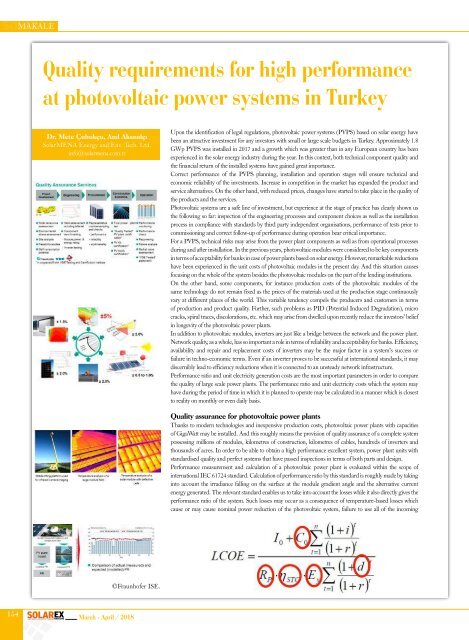You also want an ePaper? Increase the reach of your titles
YUMPU automatically turns print PDFs into web optimized ePapers that Google loves.
MAKALE<br />
Quality requirements for high performance<br />
at photovoltaic power systems in Turkey<br />
Dr. Mete Çubukçu, Anıl Akanalçı<br />
SolarMENA Energy and Env. Tech. Ltd.<br />
info@solarmena.com.tr<br />
Upon the identification of legal regulations, photovoltaic power systems (PVPS) based on solar energy have<br />
been an attractive investment for any investors with small or large scale budgets in Turkey. Approximately 1.8<br />
GWp PVPS was installed in 2017 and a growth which was greater than in any European country has been<br />
experienced in the solar energy industry during the year. In this context, both technical component quality and<br />
the financial return of the installed systems have gained great importance.<br />
Correct performance of the PVPS planning, installation and operation stages will ensure technical and<br />
economic reliability of the investments. Increase in competition in the market has expanded the product and<br />
service alternatives. On the other hand, with reduced prices, changes have started to take place in the quality of<br />
the products and the services.<br />
Photovoltaic systems are a safe line of investment, but experience at the stage of practice has clearly shown us<br />
the following so far: inspection of the engineering processes and component choices as well as the installation<br />
process in compliance with standards by third party independent organisations, performance of tests prior to<br />
commissioning and correct follow-up of performance during operation bear critical importance.<br />
For a PVPS, technical risks may arise from the power plant components as well as from operational processes<br />
during and after installation. In the previous years, photovoltaic modules were considered to be key components<br />
in terms of acceptability for banks in case of power plants based on solar energy. However, remarkable reductions<br />
have been experienced in the unit costs of photovoltaic modules in the present day. And this situation causes<br />
focusing on the whole of the system besides the photovoltaic modules on the part of the lending institutions.<br />
On the other hand, some components, for instance production costs of the photovoltaic modules of the<br />
same technology do not remain fixed as the prices of the materials used at the production stage continuously<br />
vary at different places of the world. This variable tendency compels the producers and customers in terms<br />
of production and product quality. Further, such problems as PID (Potential Induced Degradation), micro<br />
cracks, spiral traces, discolorations, etc. which may arise from dwelled upon recently reduce the investors’ belief<br />
in longevity of the photovoltaic power plants.<br />
In addition to photovoltaic modules, inverters are just like a bridge between the network and the power plant.<br />
Network quality, as a whole, has so important a role in terms of reliability and acceptability for banks. Efficiency,<br />
availability and repair and replacement costs of inverters may be the major factor in a system’s success or<br />
failure in techno-economic terms. Even if an inverter proves to be successful at international standards, it may<br />
discernibly lead to efficiency reductions when it is connected to an unsteady network infrastructure.<br />
Performance ratio and unit electricity generation costs are the most important parameters in order to compare<br />
the quality of large scale power plants. The performance ratio and unit electricity costs which the system may<br />
have during the period of time in which it is planned to operate may be calculated in a manner which is closest<br />
to reality on monthly or even daily basis.<br />
Quality assurance for photovoltaic power plants<br />
Thanks to modern technologies and inexpensive production costs, photovoltaic power plants with capacities<br />
of GigaWatt may be installed. And this roughly means the provision of quality assurance of a complete system<br />
possessing millions of modules, kilometres of construction, kilometres of cables, hundreds of inverters and<br />
thousands of acres. In order to be able to obtain a high performance excellent system, power plant units with<br />
standardised quality and perfect systems that have passed inspections in terms of both parts and design.<br />
Performance measurement and calculation of a photovoltaic power plant is evaluated within the scope of<br />
international IEC 61724 standard. Calculation of performance ratio by this standard is roughly made by taking<br />
into account the irradiance falling on the surface at the module gradient angle and the alternative current<br />
energy generated. The relevant standard enables us to take into account the losses while it also directly gives the<br />
performance ratio of the system. Such losses may occur as a consequence of temperature-based losses which<br />
cause or may cause nominal power reduction of the photovoltaic system, failure to use all of the incoming<br />
©Fraunhofer ISE.<br />
154<br />
March - April / <strong>2018</strong>

















